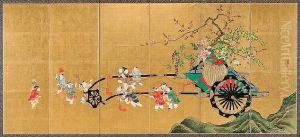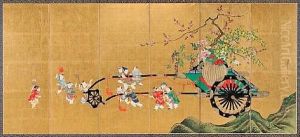Ooka Shumboku Paintings
Ooka Shumboku was a distinguished Japanese painter, calligrapher, and poet active during the Edo period, a time marked by economic growth, strict social order, isolationist foreign policies, popular enjoyment of arts and culture, and sustainable forest management. Born in 1680, Shumboku was part of the rich tapestry of Japanese art that flourished under the Tokugawa shogunate. His work is often associated with the Rinpa school, one of the major historical schools of Japanese painting, though he was known for his unique contributions and interpretations that expanded the boundaries of traditional Rinpa aesthetics.
Shumboku’s artistry was deeply influenced by the earlier masters of the Rinpa school, such as Hon'ami Kōetsu and Tawaraya Sōtatsu, focusing on the natural world, courtly themes, and classical Japanese literature. However, he infused his work with a personal touch that often reflected his scholarly interests and poetic inclination. His paintings are characterized by their delicate beauty, meticulous detail, and the use of vibrant colors on gold and silver leaf backgrounds, which was a hallmark of the Rinpa style.
In addition to his paintings, Shumboku was renowned for his calligraphy and poetry, mediums through which he expressed his philosophical and aesthetic ideas. He was part of a larger cultural movement in Edo-period Japan that saw a convergence of artistic and literary pursuits, where artists were not merely painters but also cultured scholars deeply engaged in the literary and intellectual discourses of their time.
Despite his contributions to the Japanese art of the Edo period, detailed records of Shumboku’s life are scarce, and much of what is known comes from the study of his surviving works and contemporary accounts. After his death in 1763, his style and approach to art continued to influence later generations of Japanese artists, contributing to the enduring legacy of the Rinpa school and its impact on Japanese cultural heritage.

